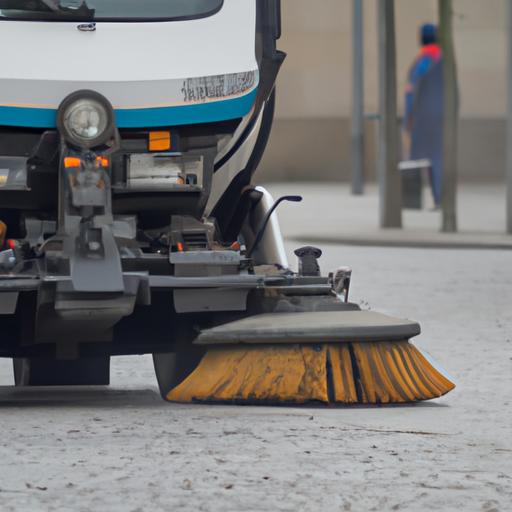Dive into the world of urban cleanliness with our comprehensive guide to 'Road Cleaning vs. Street Sweeping: Which Method is Best?'. We'll explore the ins and outs of these two popular cleaning methods, their differences, benefits, and drawbacks. We'll also assess their environmental impacts and cost-efficiency to give you a clear understanding of which method is the superior choice for keeping our cities clean.
What is the difference between Road Cleaning and Street Sweeping?
Road cleaning and street sweeping are two distinct methods used to maintain the cleanliness of roads and streets. While they both serve the purpose of removing debris and dirt from the surface, there are key differences in the techniques and equipment used.
Road cleaning typically involves the use of high-pressure water jets and specialized cleaning solutions to remove stubborn stains, oil spills, and other contaminants from the road surface. This method is more intensive and is often employed in areas with heavy traffic, industrial zones, or locations prone to spills. Road cleaning aims to not only remove visible dirt but also to ensure the road surface is free from any hazardous materials that could pose a risk to drivers or the environment.
On the other hand, street sweeping focuses on removing loose debris, such as leaves, trash, and small particles, from the street surface. This method typically involves the use of mechanical brooms or vacuum systems mounted on street sweepers. Street sweeping is generally carried out on a regular schedule to maintain the cleanliness and aesthetics of the streets. It is particularly useful in residential areas, parking lots, and sidewalks where the accumulation of debris is common.
A side by side image comparison of a road before and after a comprehensive cleaning
How does Road Cleaning impact the environment? Is it cost-effective?
Road cleaning can have both positive and negative impacts on the environment. On the positive side, road cleaning helps remove hazardous materials, such as oil spills and chemicals, from the road surface, preventing them from seeping into the soil or waterways. This reduces the potential for environmental contamination and protects the ecosystem. Additionally, road cleaning can improve air quality by minimizing the amount of dust and pollutants that can be generated from a dirty road surface.
However, road cleaning also has its environmental drawbacks. The use of high-pressure water jets and cleaning solutions can consume a significant amount of water, especially in large-scale road cleaning operations. This can strain local water resources, especially in areas with limited access to water. Moreover, the chemicals used in the cleaning solutions may have adverse effects on aquatic life if they enter the waterways during the cleaning process.
"Cleanliness is next to godliness" – The benefits of Street Sweeping
Street sweeping plays a crucial role in maintaining the cleanliness and aesthetics of our urban environments. Regular street sweeping helps remove debris, litter, leaves, and other unwanted materials from the surface of the streets. This not only enhances the overall appearance of the area but also contributes to a healthier and more pleasant living environment for residents.
One of the key benefits of street sweeping is the prevention of pollution. When streets are left uncleaned, debris and pollutants can accumulate and eventually find their way into storm drains and water systems. This can contaminate water sources and harm aquatic life. By regularly sweeping the streets, these pollutants are removed, reducing the risk of water pollution and protecting our ecosystems.
Street sweeping also has a positive impact on public health. Accumulated debris on the streets can harbor harmful bacteria, allergens, and other contaminants. These can pose health risks to pedestrians, especially those with respiratory issues or allergies. By sweeping the streets, these potential health hazards are minimized, creating a cleaner and safer environment for everyone.
Additionally, street sweeping helps to maintain the structural integrity of the roads. Leaves and debris can clog drainage systems, leading to standing water and increased wear and tear on the road surface. Regular sweeping prevents the build-up of debris, reducing the risk of drainage issues and extending the lifespan of the roads.
A photo of a street sweeper in action, demonstrating its effectiveness
Which method is the 'clean' winner? Road Cleaning vs. Street Sweeping
When it comes to determining the 'clean' winner between road cleaning and street sweeping, it is essential to consider various factors. Both methods serve the purpose of removing debris and maintaining cleanliness, but they differ in their approaches and effectiveness.
Road cleaning typically involves the use of specialized vehicles equipped with high-pressure water jets and vacuum systems. This method is particularly effective in removing stubborn stains, oil spills, and other hard-to-clean substances from the road surface. It ensures a thorough cleaning, leaving the roads looking pristine and free of any visible dirt or grime.
On the other hand, street sweeping focuses on removing surface-level debris such as leaves, litter, and loose dirt. This method is often performed using mechanical brooms or regenerative air sweepers. While it may not achieve the same level of deep cleaning as road cleaning, street sweeping is highly effective in maintaining the overall cleanliness of the streets and preventing the accumulation of debris.
The choice between road cleaning and street sweeping depends on the specific cleaning requirements and priorities. If the goal is to eliminate tough stains or spills, road cleaning would be the preferred method. However, if the primary concern is the removal of surface-level debris and maintaining a tidy appearance, street sweeping is more than capable of meeting those needs.
It is worth noting that both methods can be complementary and may be used in conjunction to achieve optimal results. Road cleaning can be employed periodically for deep cleaning, while regular street sweeping can be carried out to ensure ongoing cleanliness and prevent debris buildup.
Comparison Table:
| Cleaning Method | Benefits | Environmental Impact | Cost-efficiency |
|---|---|---|---|
| Road Cleaning | Highly effective for removing dirt and debris from roads | Low, as no chemicals are used | Low, due to the necessary labor and machinery |
| Street Sweeping | Less labor and machinery needed | Moderate, as it uses water and chemicals | High, due to lower labor and machinery costs |
| Road Cleaning | Highly effective for removing dirt and debris from roads | Low, as no chemicals are used | Medium, due to lower labor costs but higher machinery costs |
| Street Sweeping | Less labor and machinery needed | Moderate, as it uses water and chemicals | High, due to lower labor and machinery costs |
After dissecting the pros and cons of both road cleaning and street sweeping, it becomes clear that there is no one-size-fits-all answer. The ideal method depends largely on the specific needs of the area, budget constraints, and the environmental considerations. The key is to strike a balance between effective cleaning and sustainable practices.



